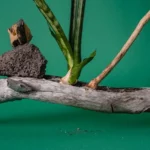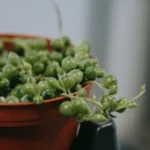The asparagus fern is a lovely green feathery flowering plant. It is also known as the lace fern, asparagus grass, and climbing asparagus. This species is not a true fern.
It is from the lily family, but its name comes from its appearance because it looks so much like a fern plant.
The species is native to the Cape Provinces and the Northern Provinces of South Africa. While it is not a common houseplant, it does make a wonderful one.
While sometimes this plant is considered a weed, it makes a lovely houseplant. Over time, and in the right conditions, they may produce greeny-white bell-shaped flowers that turn into purple-red berries.
Because it may develop thorns, handlers must use care. These plants are often placed in hanging baskets because of their long stems. They can be used to decorate the home, patio, porch, or other locations.
Table of Contents
How To Care For An Asparagus Fern
Asparagus fern care is considered fairly easy. These plants have minimal basic requirements to fulfill.
As long as these provisions are met, the plants are fast growers.
Read more: Asparagus Fern Propagation
Asparagus Fern Care Requirements
Below are the minimal asparagus fern care requirements. While the species of plant is resilient, if the basics are not met, it may not develop as it should.
Typically, the ferns may grow up to three feet wide, with trailers up to four feet long.
Light Requirements
This species requires bright but indirect sunlight, preferably from a north, east or west-facing window.
Direct sunshine may burn the needles. Insufficient light could cause the needles to turn yellow and drop off.
Asparagus Fern Temperature Requirements
An asparagus fern likes an average room temperature of between 20-23 degrees Celsius (68-73 degrees Fahrenheit) but can grow in temperatures as low as 10 degrees Celsius (50 degrees Fahrenheit).
If they must, they can live briefly in air as cold as 2 degrees Celsius (36 degrees Fahrenheit).
Humidity Requirements
These plants can survive in low-medium humidity levels. This requirement is because it is a part of the lily family and not the fern family.
Asparagus Fern Watering
The asparagus fern requires slightly more water than some houseplants. It needs to be well-watered without allowing the roots to sit in the moisture.
You can allow the top half of the potting mix to dry before watering. In the winter, fewer waterings are required. However, the soil should never be dry.
To prevent overwatering, you can wait until the fronds turn pale green before adding more liquid. The presentation of yellow stems means the plant is underwatered, while brown stems mean it has been given too much.
Asparagus Fern Soil Requirements
The best choice is well-aerated, quick-draining, slightly acidic potting soil. Potting mix that is too heavy can have peat moss, perlite, or sand added to it. These plants should be rooted in small pots. This limited space encourages long roots to grow.
Best Fertilizer For Asparagus Fern
Weak water-soluble fertilizer may be added every week during the summer. During the spring and fall, it can be applied each month. Plant food is not required during the winter. Regular strength fertilizer should be diluted to half-strength.
Extra Tips For Asparagus Fern Care
Asparagus fern care may be simple, and this species is quite resilient to illness. However, it always helps to have additional details and tips concerning any potential issues with insects and illnesses, as well as those pertaining to pruning and propagation.
Asparagus fern Pests and Diseases
You should note that these plants do not like pesticides. Asparagus fern care and treatment for any issues that arise may be done with insecticidal soap or natural treatments suitable for the species.
- Mealybugs: These creatures are typically white or pale pink. Their bodies are segmented. While they are small, they are visible when inspecting the plant. They may be on the stems near the soil or near the joints where the stems branch off. One particularly noticeable symptom of an infestation aside from sighting the insects is the yellowing of the needles.
- Spider Mites: These small creatures are difficult to get rid of once they arrive. The plant must be separated from other plants if there is an infestation. These insects are small, and they may be red, black, or white. Needles will often turn yellow when the plant is infested.
- Aphids: These yellow-orange pests lodge themselves on the stems and needles of the plants. They tend to cause damage that is similar in appearance to what the other insects create.
- Scale: Scale insects are tiny and look like little bumps on the stems. They secrete a sticky substance which might be one of the first signs of their presence. When they start to cause damage to the plant, the stems may start to look discolored.
- Thrips: These creatures are slim brown insects that can cause great damage to seedlings and adult plants. Their feeding will cause the plant color to turn yellowish-gray, and in general, the fern will look ragged. Eventually, the branchlets will drop if the infestation continues.
- Root Rot: This fungal disease is often caused by too much moisture in the soil. It will cause the plant to stop growing and the needles to turn yellow, possibly brown. The stems and roots will turn and go mushy if not treated. If this issue is caught when the roots only have a yellow tinge to them, you may not require special natural fungicides. However, any worsening from this point may require treatments and repotting.
Read more: Why is Your Asparagus Fern Turning Yellow
Asparagus Fern Pruning
Pruning is rarely a part of asparagus fern care. However, trimming can be done to remove yellowing stems caused by illness, insects, or stress.
The cuts should be made by sharp, sterilized scissors as close to the soil as possible.
Asparagus Fern Propagation
Propagation is completed through plant division. This procedure is best done during the spring before it develops new growth.
The plant must be removed from the pot and the potting soil loosened around the root ball. The root ball is very tough. You may require strong tools for the division process.
Toxicity
The asparagus fern plant is toxic to humans and dogs. The berries are poisonous when ingested. It is advised to wear gloves while working on its foliage and keep the plant out of reach of pets.
Photo by Ksenia Chernaya from Pexels


